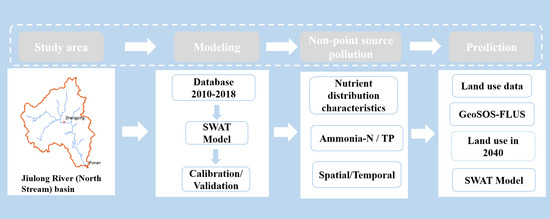Spatio-Temporal Dynamics of Non-Point Source Pollution in Jiulong River Basin (China) Using the Soil & Water Assessment Tool Model in Combination with the GeoSOS-FLUS Model
Abstract
1. Introduction
2. Materials and Methods
2.1. Study Area
2.2. Data Collection and Processing
2.3. SWAT Model for Water Quantity and Quality Simulation in the Jiulong River (North Stream)
2.4. Future Land Use Forecasting Using the GeoSOS-FLUS Model
2.5. Identification of Key Pollution Source Areas
3. Results and Discussion
3.1. SWAT Model Calibration and Validation
3.2. Temporal Variations of Ammonia-N and TP Mass Load in the North Stream of Jiulong River (North Stream)
3.3. Spatial Distributions of Ammonia-N and TP Mass Load in the North Stream of Jiulong River
3.4. Prediction of Ammonia-N and TP Pollution Load in 2040 Using GeoSOS-FLUS Model in Combination with SWAT Model
4. Conclusions
Supplementary Materials
Author Contributions
Funding
Data Availability Statement
Acknowledgments
Conflicts of Interest
References
- Wan, W.; Han, Y.; Wu, H.; Liu, F.; Liu, Z. Application of the Source–Sink Landscape Method in the Evaluation of Agricultural Non-Point Source Pollution: First Estimation of an Orchard-Dominated Area in China. Agric. Water Manag. 2021, 252, 106910. [Google Scholar] [CrossRef]
- Zou, L.; Liu, Y.; Wang, Y.; Hu, X. Assessment and Analysis of Agricultural Non-Point Source Pollution Loads in China: 1978–2017. J. Environ. Manag. 2020, 263, 110400. [Google Scholar] [CrossRef]
- Xue, J.; Wang, Q.; Zhang, M. A Review of Non-Point Source Water Pollution Modeling for the Urban–Rural Transitional Areas of China: Research Status and Prospect. Sci. Total Environ. 2022, 826, 154146. [Google Scholar] [CrossRef] [PubMed]
- Xueman, Y.; Wenxi, L.; Yongkai, A.; Weihong, D. Assessment of Parameter Uncertainty for Non-Point Source Pollution Mechanism Modeling: A Bayesian-Based Approach. Environ. Pollut. 2020, 263, 114570. [Google Scholar] [CrossRef] [PubMed]
- Zhang, X.; Chen, P.; Dai, S.; Han, Y. Analysis of Non-Point Source Nitrogen Pollution in Watersheds Based on SWAT Model. Ecol. Indic. 2022, 138, 108881. [Google Scholar] [CrossRef]
- Santos, F.M.D.; De Oliveira, R.P.; Mauad, F.F. Evaluating a Parsimonious Watershed Model versus SWAT to Estimate Streamflow, Soil Loss and River Contamination in Two Case Studies in Tietê River Basin, São Paulo, Brazil. J. Hydrol. Reg. Stud. 2020, 29, 100685. [Google Scholar] [CrossRef]
- Di Matteo, M.; Dandy, G.C.; Maier, H.R. A Multi-Stakeholder Portfolio Optimization Framework Applied to Stormwater Best Management Practice (BMP) Selection. Environ. Model. Softw. 2017, 97, 16–31. [Google Scholar] [CrossRef]
- Tatum, V.L.; Jackson, C.R.; McBroom, M.W.; Baillie, B.R.; Schilling, E.B.; Wigley, T.B. Effectiveness of Forestry Best Management Practices (BMPs) for Reducing the Risk of Forest Herbicide Use to Aquatic Organisms in Streams. For. Ecol. Manag. 2017, 404, 258–268. [Google Scholar] [CrossRef]
- Fan, J.; Kuang, C.; Liu, H.; Wang, D.; Liu, J.; Wang, G.; Zou, Q. Impact of Artificial Islands and Reefs on Water Quality in Jinmeng Bay, China. Water 2023, 15, 959. [Google Scholar] [CrossRef]
- Li, H.; Zhang, J.; Zhang, S.; Zhang, W.; Zhang, S.; Yu, P.; Song, Z. A Framework to Assess Spatio-Temporal Variations of Potential Non-Point Source Pollution Risk for Future Land-Use Planning. Ecol. Indic. 2022, 137, 108751. [Google Scholar] [CrossRef]
- Lu, W.; Lei, H.; Yang, D.; Tang, L.; Miao, Q. Quantifying the Impacts of Small Dam Construction on Hydrological Alterations in the Jiulong River Basin of Southeast China. J. Hydrol. 2018, 567, 382–392. [Google Scholar] [CrossRef]
- Datok, P.; Sauvage, S.; Fabre, C.; Laraque, A.; Ouillon, S.; Moukandi N’kaya, G.; Sanchez-Perez, J.-M. Sediment Balance Estimation of the ‘Cuvette Centrale’ of the Congo River Basin Using the SWAT Hydrological Model. Water 2021, 13, 1388. [Google Scholar] [CrossRef]
- Sun, X.; Hu, Z.; Li, M.; Liu, L.; Xie, Z.; Li, S.; Wang, G.; Liu, F. Optimization of Pollutant Reduction System for Controlling Agricultural Non-Point-Source Pollution Based on Grey Relational Analysis Combined with Analytic Hierarchy Process. J. Environ. Manag. 2019, 243, 370–380. [Google Scholar] [CrossRef]
- Lin, C.; Wang, Y.; Hu, G.; Yu, R.; Huang, H. Source Apportionment and Transfer Characteristics of Pb in a Soil-Rice-Human System, Jiulong River Basin, Southeast China. Environ. Pollut. 2023, 326, 121489. [Google Scholar] [CrossRef] [PubMed]
- Mandrekar, J.N. Receiver Operating Characteristic Curve in Diagnostic Test Assessment. J. Thorac. Oncol. 2010, 5, 1315–1316. [Google Scholar] [CrossRef]
- Hou, C.; Chu, M.L.; Botero-Acosta, A.; Guzman, J.A. Modeling Field Scale Nitrogen Non-Point Source Pollution (NPS) Fate and Transport: Influences from Land Management Practices and Climate. Sci. Total Environ. 2021, 759, 143502. [Google Scholar] [CrossRef]
- He, R.; Yang, X.; Gassman, P.W.; Wang, G.; Yu, C. Spatiotemporal Characterization of Nutrient Pollution Source Compositions in the Xiaohong River Basin, China. Ecol. Indic. 2019, 107, 105676. [Google Scholar] [CrossRef]
- Multi-Scenario Simulation and Optimization Control of Ecological Security Based on GeoSOS-FLUS Model in Ecological Fragile Area in Northeast Qinghai-Tibet Plateau, China—ScienceDirect. Available online: https://www.sciencedirect.com/science/article/pii/S1470160X23004661 (accessed on 12 June 2023).
- Wang, H.; Liu, C.; Xiong, L.; Wang, F. The Spatial Spillover Effect and Impact Paths of Agricultural Industry Agglomeration on Agricultural Non-Point Source Pollution: A Case Study in Yangtze River Delta, China. J. Clean. Prod. 2023, 401, 136600. [Google Scholar] [CrossRef]
- Wang, L.; Dang, D.; Liu, Y.; Peng, X.; Liu, R. Dynamic Water Environment Capacity Assessment Based on Control Unit Coupled with SWAT Model and Differential Evolution Algorithm. Water 2023, 15, 1817. [Google Scholar] [CrossRef]
- Bui, H.H.; Ha, N.H.; Nguyen, T.N.D.; Nguyen, A.T.; Pham, T.T.H.; Kandasamy, J.; Nguyen, T.V. Integration of SWAT and QUAL2K for Water Quality Modeling in a Data Scarce Basin of Cau River Basin in Vietnam. Ecohydrol. Hydrobiol. 2019, 19, 210–223. [Google Scholar] [CrossRef]
- Wang, Q.; Liu, R.; Men, C.; Guo, L. Application of Genetic Algorithm to Land Use Optimization for Non-Point Source Pollution Control Based on CLUE-S and SWAT. J. Hydrol. 2018, 560, 86–96. [Google Scholar] [CrossRef]
- Zhang, P.; Liu, Y.; Pan, Y.; Yu, Z. Land Use Pattern Optimization Based on CLUE-S and SWAT Models for Agricultural Non-Point Source Pollution Control. Math. Comput. Model. 2013, 58, 588–595. [Google Scholar] [CrossRef]
- Mansour, S.; Al-Belushi, M.; Al-Awadhi, T. Monitoring Land Use and Land Cover Changes in the Mountainous Cities of Oman Using GIS and CA-Markov Modelling Techniques. Land Use Policy 2020, 91, 104414. [Google Scholar] [CrossRef]
- Jin, H.; Li, H.; Lee, J.; Sun, W. Simulation Analysis of Rural Land Use Using Rate of Change Driven by Population and Economic Dynamics—A Case Study of Huangguashan Village in Chongqing, China. Ecol. Model. 2023, 475, 110204. [Google Scholar] [CrossRef]
- Liu, X.; Liang, X.; Li, X.; Xu, X.; Ou, J.; Chen, Y.; Li, S.; Wang, S.; Pei, F. A Future Land Use Simulation Model (FLUS) for Simulating Multiple Land Use Scenarios by Coupling Human and Natural Effects. Landsc. Urban Plan. 2017, 168, 94–116. [Google Scholar] [CrossRef]
- Wang, Y.; Shen, J.; Yan, W.; Chen, C. Backcasting Approach with Multi-Scenario Simulation for Assessing Effects of Land Use Policy Using GeoSOS-FLUS Software. MethodsX 2019, 6, 1384–1397. [Google Scholar] [CrossRef]
- Huang, H.; Lin, C.; Yu, R.; Yan, Y.; Hu, G.; Wang, Q. Spatial Distribution and Source Appointment of Rare Earth Elements in Paddy Soils of Jiulong River Basin, Southeast China. J. Geochem. Explor. 2019, 200, 213–220. [Google Scholar] [CrossRef]
- Yang, X.; Cai, S.; Wu, X.; Zhang, Y.; Li, D.; Chen, Y.; Chen, Q.; Zhu, S.; Yan, D.; Xu, W.; et al. Analysis of the Distribution Characteristics of Enterovirus Types Based on Environmental Surveillance from 2013 to 2021 in Fujian Province, China. Biosaf. Health 2023. [Google Scholar] [CrossRef]
- Assessment of Nitrogen Reduction by Constructed Wetland Based on InVEST: A Case Study of the Jiulong River Watershed, China—ScienceDirect. Available online: https://www.sciencedirect.com/science/article/pii/S0025326X18303795 (accessed on 12 June 2023).
- Liu, Z.; Rong, L.; Wei, W. Impacts of Land Use/Cover Change on Water Balance by Using the SWAT Model in a Typical Loess Hilly Watershed of China. Geogr. Sustain. 2023, 4, 19–28. [Google Scholar] [CrossRef]
- Sharma, A.; Patel, P.L.; Sharma, P.J. Influence of Climate and Land-Use Changes on the Sensitivity of SWAT Model Parameters and Water Availability in a Semi-Arid River Basin. Catena 2022, 215, 106298. [Google Scholar] [CrossRef]
- Liu, X.; Wei, M.; Li, Z.; Zeng, J. Multi-Scenario Simulation of Urban Growth Boundaries with an ESP-FLUS Model: A Case Study of the Min Delta Region, China. Ecol. Indic. 2022, 135, 108538. [Google Scholar] [CrossRef]
- Abouali, M.; Nejadhashemi, A.P.; Daneshvar, F.; Adhikari, U.; Herman, M.R.; Calappi, T.J.; Rohn, B.G. Evaluation of Wetland Implementation Strategies on Phosphorus Reduction at a Watershed Scale. J. Hydrol. 2017, 552, 105–120. [Google Scholar] [CrossRef]
- Wang, S.; Wang, Y.; Wang, Y.; Wang, Z. Assessment of Influencing Factors on Non-Point Source Pollution Critical Source Areas in an Agricultural Watershed. Ecol. Indic. 2022, 141, 109084. [Google Scholar] [CrossRef]
- Han, Y.; Liu, Z.; Chen, Y.; Li, Y.; Liu, H.; Song, L.; Chen, Y. Assessing Non-Point Source Pollution in an Apple-Dominant Basin and Associated Best Fertilizer Management Based on SWAT Modeling. Int. Soil Water Conserv. Res. 2023, 11, 353–364. [Google Scholar] [CrossRef]
- Electrochemical Ammonia Removal and Disinfection of Aquaculture Wastewater Using Batch and Flow Reactors Incorporating PtRu/Graphite Anode and Graphite Cathode—ScienceDirect. Available online: https://www.sciencedirect.com/science/article/pii/S014486092100011X (accessed on 12 June 2023).
- Li, H.; Cui, Z.; Cui, H.; Bai, Y.; Yin, Z.; Qu, K. Hazardous Substances and Their Removal in Recirculating Aquaculture Systems: A Review. Aquaculture 2023, 569, 739399. [Google Scholar] [CrossRef]
- de Oliveira, L.M.; Maillard, P.; de Andrade Pinto, E.J. Application of a Land Cover Pollution Index to Model Non-Point Pollution Sources in a Brazilian Watershed. Catena 2017, 150, 124–132. [Google Scholar] [CrossRef]
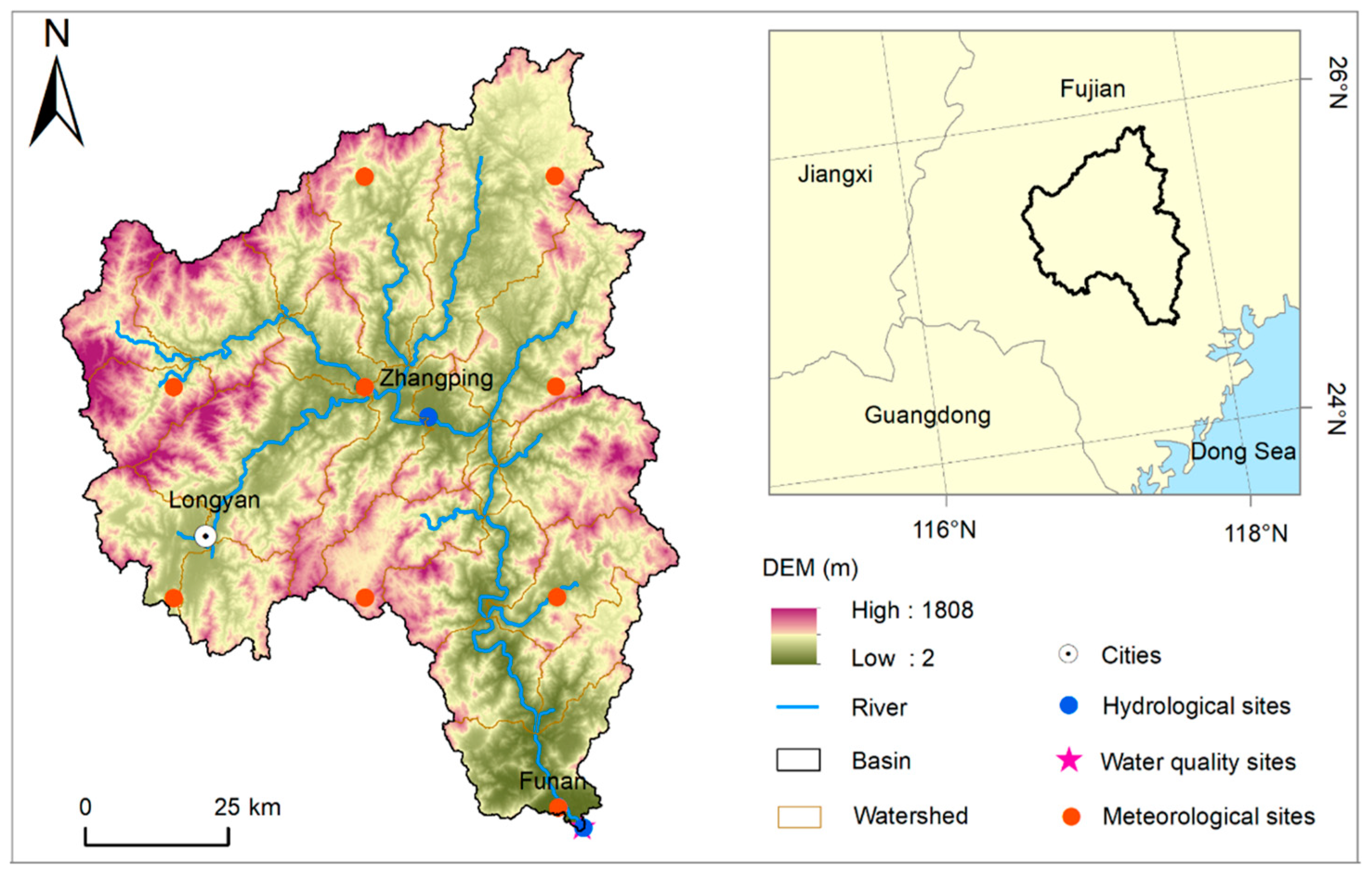


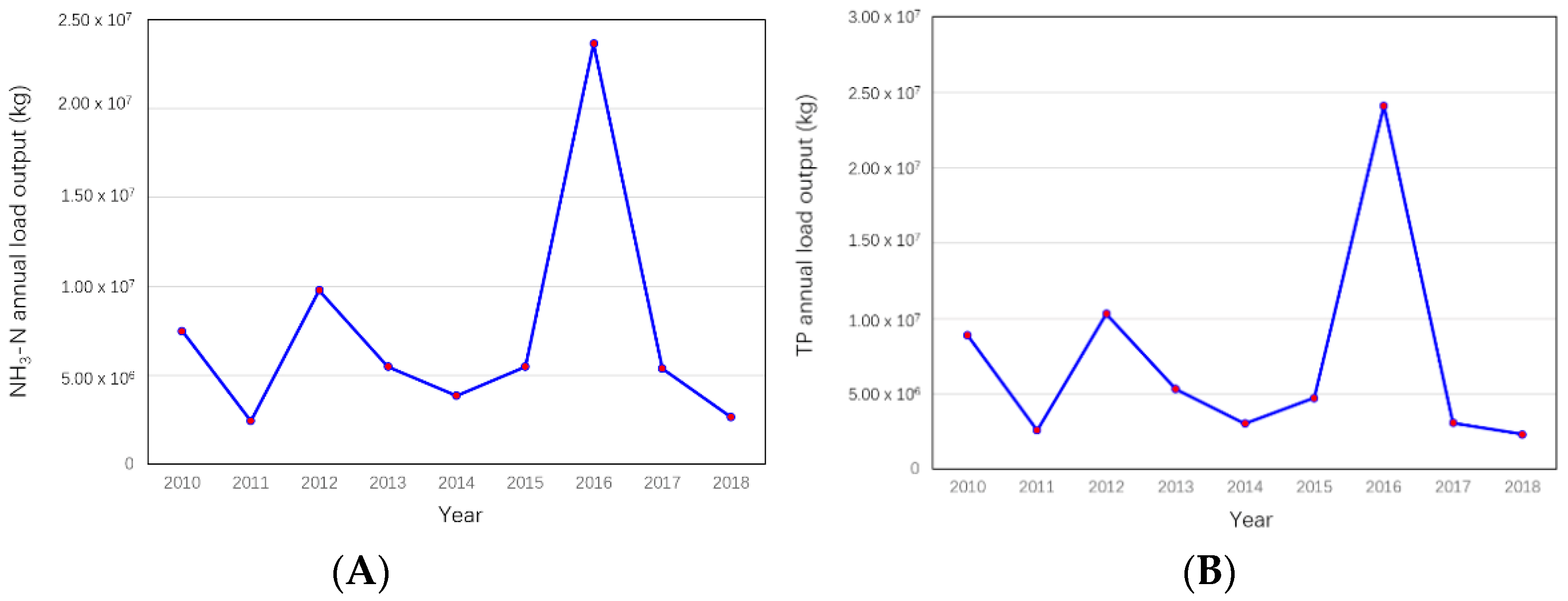


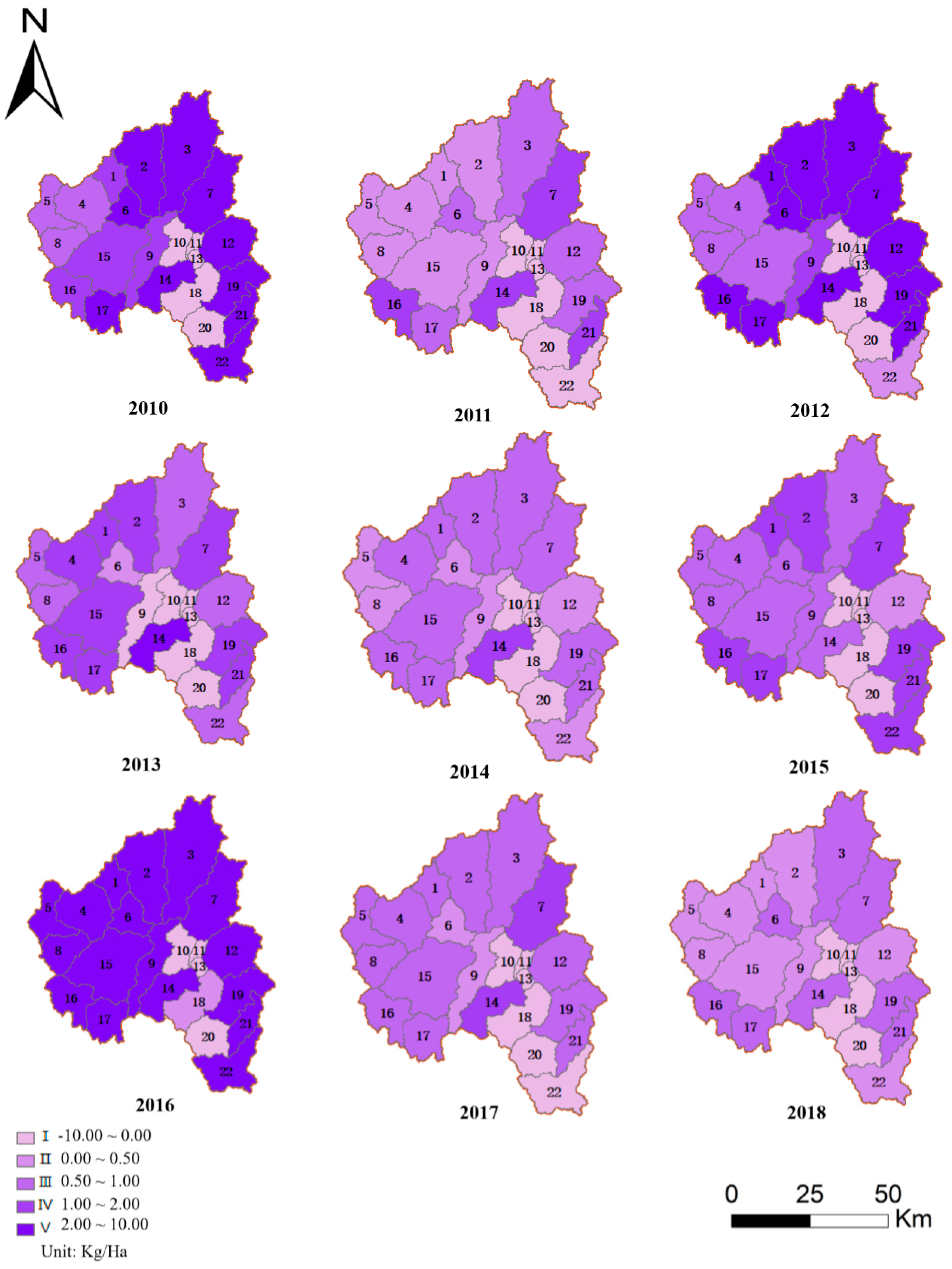
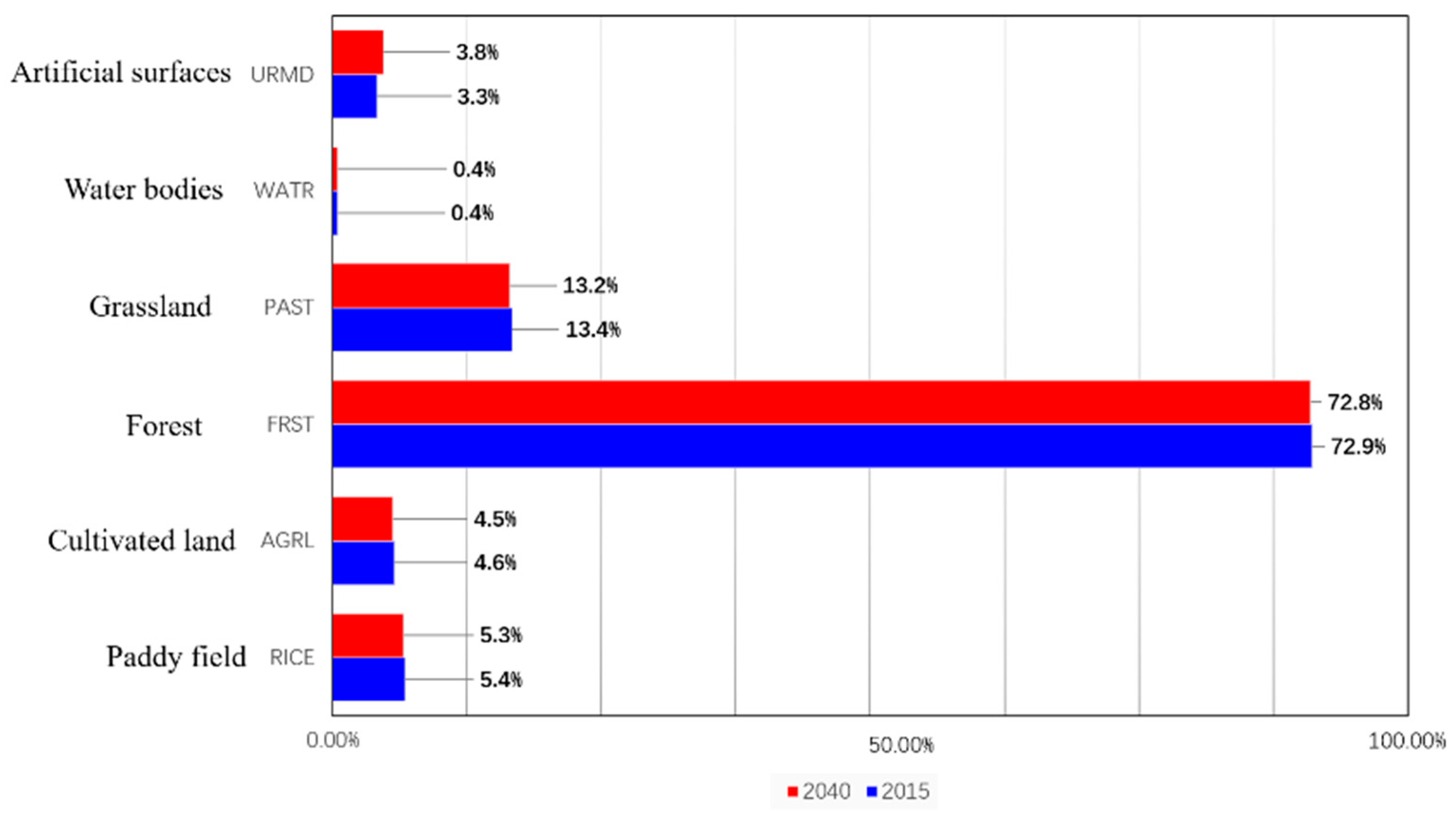


| Data Type | Indicator | Time Period | Resolution | Source |
|---|---|---|---|---|
| Digital elevation model (DEM) | Elevation data | 2015 | 30 m | Geospatial Data Cloud (https://www.gscloud.cn (accessed on 6 May 2022)) |
| Land use | Land use type | 2018 | 30 m | Geospatial Data Cloud |
| Soil data | Soil type | 2015 | 1:1,000,000 | Soil Science Database (https://www.geodata.cn (accessed on 6 May 2022)) |
| Meteorological data | Precipitation, wind speed, sunshine, humidity, and temperature (mean, maxima, and minima) | 2010–2018 | Daily | Precipitation stations Weather stations |
| Measured hydrological data | Runoff | 2010–2018 | Daily | China Hydrologic Data Year Book |
| Measured water quality data | Ammonia-N and TP | 2010–2018 | Monthly | Ministry of Ecology and Environment of the People’s Republic of China Fujian Provincial Department of Ecology and Environment |
Disclaimer/Publisher’s Note: The statements, opinions and data contained in all publications are solely those of the individual author(s) and contributor(s) and not of MDPI and/or the editor(s). MDPI and/or the editor(s) disclaim responsibility for any injury to people or property resulting from any ideas, methods, instructions or products referred to in the content. |
© 2023 by the authors. Licensee MDPI, Basel, Switzerland. This article is an open access article distributed under the terms and conditions of the Creative Commons Attribution (CC BY) license (https://creativecommons.org/licenses/by/4.0/).
Share and Cite
Li, Z.; Xue, W.; Winijkul, E.; Shrestha, S. Spatio-Temporal Dynamics of Non-Point Source Pollution in Jiulong River Basin (China) Using the Soil & Water Assessment Tool Model in Combination with the GeoSOS-FLUS Model. Water 2023, 15, 2763. https://doi.org/10.3390/w15152763
Li Z, Xue W, Winijkul E, Shrestha S. Spatio-Temporal Dynamics of Non-Point Source Pollution in Jiulong River Basin (China) Using the Soil & Water Assessment Tool Model in Combination with the GeoSOS-FLUS Model. Water. 2023; 15(15):2763. https://doi.org/10.3390/w15152763
Chicago/Turabian StyleLi, Zheng, Wenchao Xue, Ekbordin Winijkul, and Sangam Shrestha. 2023. "Spatio-Temporal Dynamics of Non-Point Source Pollution in Jiulong River Basin (China) Using the Soil & Water Assessment Tool Model in Combination with the GeoSOS-FLUS Model" Water 15, no. 15: 2763. https://doi.org/10.3390/w15152763
APA StyleLi, Z., Xue, W., Winijkul, E., & Shrestha, S. (2023). Spatio-Temporal Dynamics of Non-Point Source Pollution in Jiulong River Basin (China) Using the Soil & Water Assessment Tool Model in Combination with the GeoSOS-FLUS Model. Water, 15(15), 2763. https://doi.org/10.3390/w15152763







